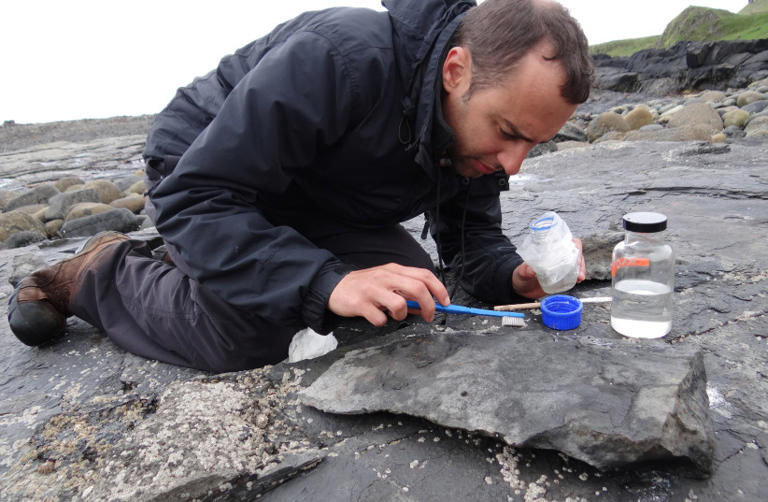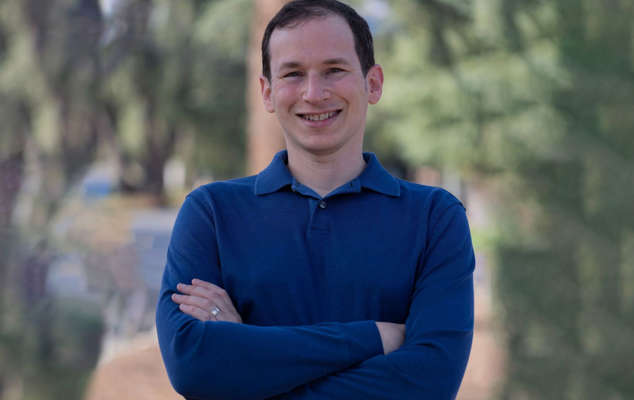Historian Christopher Clark, author of "The Sleepwalkers: How Europe Went to War in 1914" discusses with DW the complexities of war, and why Putin's behavior does not represent Russia.

World War I developed into a full-blown conflict involving many countries
DW: Your book "Sleepwalkers" caused people to rethink the First World War, and whether it was just Germany starting the war, or whether it was rather many European nations sleepwalking into a massive battle. What was your ultimate conclusion in your work?
Christopher Clark: Well, I think the conclusion of the book about 1914 was that the causes behind this war were complex.
A debate had been underway — which is still not finished — about what brought this war about. That's because the story was so complex.
And so I suppose the book was really making a plea for complexity, to understand how complex these things are. That was the first main point.
And the second argument was that we need to think about not just why wars come about and who's guilty for the outbreak of war. We also need to think about how they come about in order to be able to do better next time.
For example, if you think about the current war in the Ukraine, if we simply decide Mr. Putin is a very bad man and he caused a war and that's the end of it, we will learn nothing from this war.
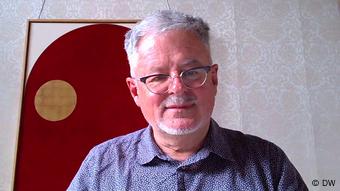
Clark has a deep understanding of European history
We can learn much more if we think about the whole story of how this situation came about. It wouldn't in any way ease his responsibility for what has happened, which I think is unquestionable. But it would at least enable us to learn how to manage these situations better in the future.
How could we learn from that? What are the parallels between the lead-up to World War I and the current situation?
In some ways it's a lesson. It's interesting because when the [Russian-Ukrainian] conflict began, at least before the war itself actually broke out, I was reminded of the situation before 1914, because I imagined that it might be Putin's plan to send 200,000 men to the border with Ukraine and then to pull them back again, having pressured the West into concessions or Ukraine itself into concessions that didn't work.
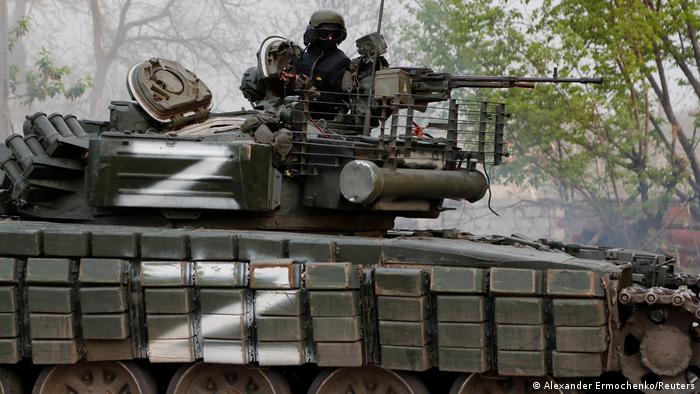
On February 24, 2022 the Russians invaded Ukraine
And then it turned out that he was planning a war all along.
So that's not like 1914, because in 1914 there is no single actor who just decides to invade another territory.
It starts in a place nobody expects, down in the Balkans, in Sarajevo, with an assassination. Then there's a complex question, you know: How will the Austrians react? How will the Serbs react to the Austrians' reaction? How will the Germans react to the Austrians' reaction to the Serbs? How will the Russians support Serbia, or not — even though the Russians are not themselves under under attack?
It's immensely complex and every power that gets pulled into this war comes in by virtue of a different logic.
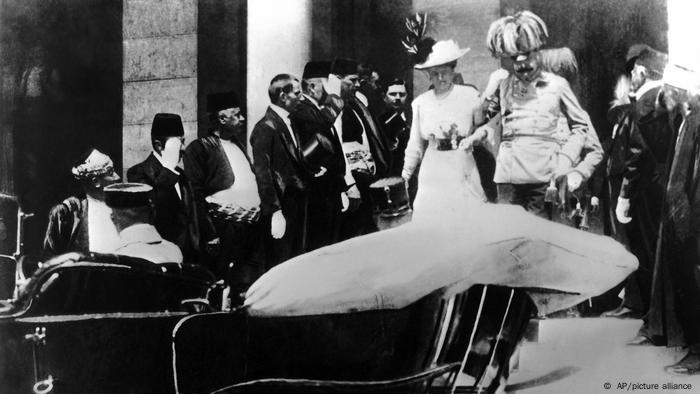
Prelude to World War I: During a visit to Sarajevo, Archduke Franz Ferdinand and his wife died in an assassination attempt
But now we have a much simpler situation. Russia is quite isolated and Putin has taken this decision himself.
Clearly, a lot of the senior people in his system were not aware of this decision until it was actually made. It's very much Putin's war. And he's currently, as far as we know from intelligence reports, actually personally playing a role in the management of this war. He makes decisions even at the level of operations.
So it's quite a different picture really from 1914. It's less complex.
You formulated the First World War as a "modern event." What did you mean by that?
I was thinking in particular of the fact that when I learned about it at school, it seemed like an event from a bygone world — all these gaudy Hapsburg uniforms, complicated rituals at court. It seemed like an oldie.
But then when I began to write this book, I realized that it begins with a motorcade, with a group of motor cars driving through a city. It involved suicide bombers — a modern figure. So it was modern in lots of ways. It wasn't a kind of old-fashioned crisis.
And it seemed to me that the arguments people made for getting involved in this war were arguments that we still hear today. For example, this tendency to play the victim, to see the provocations of the other side, but to be completely blind to the contribution you have yourself made to a crisis, to see your own measures as defensive and the measures of the opponent as offensive. These habits have clearly not died.

Clark's book was published in 2013
What have people learned in the past 100 years — or not?
We've clearly learned to do certain things much better. But whether we've become more intelligent as a political species, as a sort of as homo politicus, that's another question.
I think that's an area where we're very slow learners, and there's a tendency always to sort of fall back on old patterns of behavior.
I do think that the EU is a kind of learned historical lesson. It's the lesson of the two world wars turned into a political order.
So there are examples of lessons which have found an institutional expression and which acquire a sort of durability they might not otherwise have.
But it seems to me that in other respects, if you think about Putin — not just his decision to invade Ukraine, but his whole persona as a leader, you know, riding around shirtless on the back of a horse, all these kind of macho things; these are very atavistic.

Clark finds Putin's self-projection as a leader 'atavastic'
But on the other hand, if you look at how many of the leaders of the European states are women, if you look at how much strategizing about how to manage this aggression is being written by women: It's not the case that we haven't changed.
I think the West is a very different place from what it was and so is Russia. And there are many Russians who want to have no part of this terrible policy of risk and adventurism that Putin has embarked on.
But Putin, unfortunately, for reasons which I think are probably anchored in his biography, is someone who's reaching for atavistic patterns of behavior and self-presentation in a way that suggests we haven't learned.
Do you think then in that regard, are we on the brink of a Third World War?
Well, my first answer is I very much hope not. Like you and like everybody else.
Secondly, I think that Putin knows that this would be a sort of self extinction. He would have to be suicidal to reach for that option.

Are the Russians united behind Putin? Christopher Clark is skeptical
A lot depends on whether he's that irrational and whether his system would do that if he made a decision like that. There's a lot of evidence that the system itself would be robust enough to resist that kind of risk.
So the answer is we don't know, of course.
But if we simply let him do what he wants, then we end up licensing and effectively legitimizing his criminal breach of international law. And if, on the other hand, we overreact and over-respond, we run the risk of escalating the problem further.
But we didn't create this crisis. So the West needs to dose its responses carefully. And I think by and large, it's doing that. The fact that the arguments mainly are in the direction of the West, for responding too slowly, especially the Germans. Why aren't they delivering more, faster? Why isn't more being done for Ukraine? That suggests that we're about right, because there are others saying we're doing too much, that we're provoking
So you seem confident that the people around Putin could hold him back from pushing the nuclear button?
Well, I think that there's a lot of evidence that Putin is having difficulty with a lot of people in the wider circles of his regime system network. Putin has isolated himself more and more.
So my hope is that if there is a major decision to escalate risk through the deployment, for example, in tactical nuclear weapons, that there would be people who would say, no, we won't do that. And that has happened in the past.
Russia does not speak with one voice. Russia is a complex nation. It's a sophisticated nation. It's part of Europe. Very large numbers of Russians have left the country and are now in other places. They include many members of the intelligentsia and the media and so on. The game isn't over yet and Putin does not speak for all of Russia.
Edited by Elizabeth Grenier.








